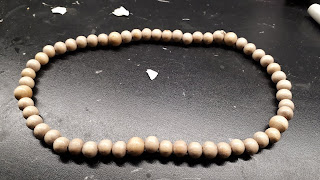At the same time, of if this maybe was the inspiration I don't remember. Studio Västsvensk konservering published this photo of a rosary.
It was found in a grave from the excavations of Nya Lödöse. Nya Lödöse was a planned effort from the state to build up a new trading port on the only access that Sweden had to the North Sea during the years 1473-1624. It was hard to attract people to Nya Lödöse, but today it's successor Gothenborg is the second largest city in Sweden so in the end it worked out. If you are curious about Nya Lödöse they have a really good and informative site on the project here. The rosary itself consists of 49 small beads and 5 large beads made of an unknown wood. The string has disappeared and the years in the ground have darkened the wood to almost black.
I didn't know the size of the beads, so I ordered beads in two different three different sizes 8 and 10 mm for the small ones and 12 mm for the large ones. I first strung the 10 mm and 12 mm beads together.
I could see straight away that there wasn't much difference between the 10 mm and 12 mm beads, so if I were to use them as a rosary it would be hard knowing when I got to the larger beads. I also wasn't happy that the beads were glossy. To take away the varnish I put the beads first in a bowl of white vinegar (ättika) and water and let it lie there for a couple of hours. The white vinegar stripped away the varnish and the water started to turn some of the beads grey. After that I put them in a bowl of cooking oil for a while as well.
The aging process worked and the beads looked a lot better. On the photo above I also have the rosary I made from 8 mm and 12 mm beads. Those beads were untreated, so since I've made them I have instead taken to sitting and rolling the rosary between my fingers, to give them a used look. they have definitely turned darker from the treatment.
 |
| Rosary of 8 mm and 10 mm unvarnished beads |
 |
| Rosary of 10 mm and 12 mm beads |
The beads are strung fairly tight. When I tried to roll the smaller rosary between my fingers, imitating the way you would use it during prayer it was also cear that it was hard to really feel the individual beads, due to them being so close to each other. This was something I had in mind when I made a third rosary.
These simple rosaries of wooden beads are great as accessories for the simpler wardrobe I use at medieval events, but I am also working on an upper class wardrobe so I wanted a rosary suitable for that as well.
Looking at 16th century portraits rosaries of red and gold beads were very popular. I really liked this rosary of red beads with golden, corrugated beads.
It turns out that coral was very popular for rosaries, because it was also seen as bringing good luck. I couldn't find large coral beads, but I did find 8 mm coral beads. Now an important thing about coral. Coral is the shell of sea creatures. Today many of the world's coral reefs are severely threatened by pollution and increased sea temperatures, there are also many cases of coral reefs being plundered to provide souvenirs and jewellery. I was very hesitant on using coral, since I don't want to help with the destruction of the reefs, but I found a Swedish supplier that explained that their coral beads were made from coral that's been farmed and harvested and doesn't come from wild coral reefs. Alternatives to using coral, and something I thought about, is agate, there are surviving medieval rosaries made of agate as well.
For the gold beads I found corrugated brass beads that looked very much like the painting, these I had to order on etsy though since I couldn't find any nice gold beads from Swedish suppliers. I strung the beads on silk cord for this rosary, and I made a knot between every set of 10 small beads so they wouldn't move around too much. For this rosary I didn't string them quite as close as the wooden rosaries, so it's easier to feel every individual bead.
 |
| The three rosaries side by side |
 |
| Even if the lady is holding the rosary it is attached to the belt |
This is the smaller rosary being worn on the belt, it also shows the size of the smallest rosary.
The Challenge: 11 above the belt
Material: 8, 10, 12 mm wood beads, 8 mm coral beads, 5 brass beads
Pattern: none, made after several paintings
Year: 16 century
Notions: The wooden rosaries are strung on linen thread, the coral one on silk chord
How historically accurate is it? 85% As far as I know this is as close as you can get, but of course the beads are not made produced as they were in the middle ages
Hours to complete: 30 min total
First worn: not yet
Total cost: The wooden rosaries - $5 the coral rosary - $15







No comments:
Post a Comment